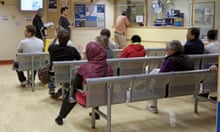Thousands of children have died or been left disabled because NHS bosses have dithered for at least a decade over introducing a checklist to spot sepsis, nurses and campaigners have claimed.
NHS chiefs in England stand accused of inaction for not ordering hospitals to bring in a standard system to detect the condition, which kills between 1,000 and 4,000 children under five every year in the UK.
Sepsis, also known as blood poisoning or septicaemia, is hard to detect because many of its symptoms, such as a high temperature, are also indicators of other illnesses. It can be the result of a severe infection and without rapid treatment can lead to organ failure, loss of limbs or death because the body’s immune system reverses its usual role and starts to attack organs and tissues.
The Royal College of Nursing (RCN) is urging NHS England and NHS Improvement to reduce child deaths from sepsis by urgently implementing the first national early warning system for identifying children whose health is deteriorating so badly that their life is at risk.
Children’s doctors, the UK Sepsis Trust and bereaved parents have joined the RCN’s call for the NHS to roll out the alert system for sepsis, which affects about 25,000 children a year.
Dame Donna Kinnair, the RCN’s chief executive, said the speed with which sepsis can change from appearing to be a minor ailment to a life-threatening illness meant all hospitals in England needed to follow an agreed system which alerted medical staff to the condition. At the moment many hospitals have their own individual versions of the scheme while some have none.
“This could save lives because you are looking for those early symptoms. What we’re saying as nurses is we believe it should be a priority,” said Kinnair.
“Sepsis in a child is so sudden, you see a child go from life to death. If you see a child and an hour later they come back with sepsis that is truly devastating for any health professional. It’s really important we get a way of ensuring that we diagnose this accurately.”

The RCN has been urging the NHS since 2007 to introduce a children’s version of the national early warning score (News) system, which helps health professionals see if a seriously ill adult’s health has suddenly worsened. Scotland already has such a scheme for under-18s. It involves staff assessing all of a patient’s vital signs together, including their temperature, heart rate and blood pressure, to judge how seriously unwell they are.
Melissa Mead, whose 12-month-old son William died of sepsis in 2014, said it was time to end what the RCN called a “postcode lottery” in different practices between hospitals.
“To have a standardised system across the country would be amazing. Ever since William died, we have been stuck in a situation where lots of different groups and people cannot decide what the standard should be, what should be measured and what it should look like,” she said.
“Why can’t people at these organisations come together for the good of the public? Thousands of children have died or suffered disability while health organisations continue to drag their heels and can’t make a decision.”
NHS Improvement has convened a group of experts to look into implementing a paediatric News system. Great Ormond Street children’s hospital, in London, has been testing a version which could be used across the NHS.
Celia Ingham Clark, the medical director for clinical effectiveness at NHS England, said: “The NHS has made huge improvements in spotting and treating sepsis quickly with screening rates in emergency departments rising from 78% in 2015 to 91% in 2018.
“The NHS is working with the Royal College of Paediatrics and Child Health to develop a national early warning system for children which will help NHS staff to rapidly identify acutely unwell children and ensure they are looked after in the most appropriate place.”








